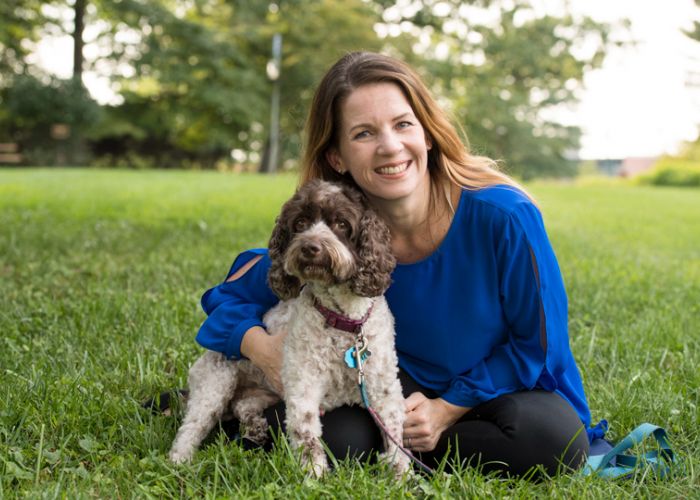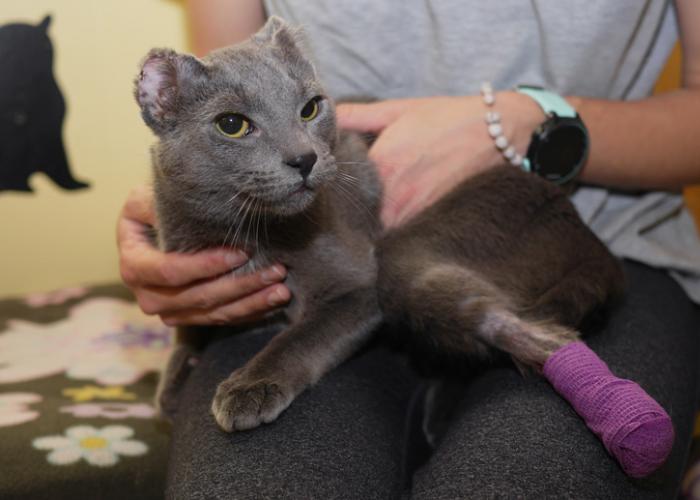Where foster and hospice care meet
Fospice programs help elderly, ill pets spend their final days surrounded by home comforts

Christopher Frey's wife Liesl loved cats and often talked about her childhood pet, an all-black feline named Midnight. And so when Liesl, 44, was hospitalized with stage IV cancer last summer, Frey contacted the San Francisco SPCA to see if a volunteer could bring a cat to visit.
But Frey learned that the hospital only allowed dogs on the palliative care ward, and so the shelter suggested he consider taking a “fospice” cat—a mashup of “foster” and “hospice”—home instead. Fospice programs allow sick or elderly animals to live out their final days with comfort and dignity in a loving home.
In July, Frey brought home Alison, a black domestic shorthair with hyperthyroidism, gastrointestinal disease and FIV; his wife’s condition declined rapidly, and she too was sent home for hospice care. For the last nine days of her life, Liesl enjoyed the company of Alison, who spent hours curled up on her bed, quietly purring.
“My wife was a lifelong lover of animals, and this made her very happy,” says Frey, an IT manager from San Jose, adding that Liesl left a bequest for homeless animals in her will. Today, he continues to care for Alison and says they both give each other comfort.
“There’s a kind of continuity there from Liesl to Alison—I think of Liesl a lot when I see Alison,” Frey explains. “And also, having somebody to snuggle with and pet because I don’t have anyone like that now. I know it’s a poor substitute, but it’s a substitute.”
Fospice programs are becoming more common, particularly as pets are living longer and shelters recognize that traditional shelter setups aren’t always able to accommodate animals with special needs, says Inga Fricke, director of sheltering initiatives and outreach for Humane World for Animals. “And for people who would like to provide care for a pet in her twilight years but are reluctant to fully take on the medical expenses associated with an elderly or terminally ill animal, fospice can be a wonderful alternative to outright adoption.”
As beneficial as fospice programs can be, Fricke notes that shelters can also provide medical and other support to help people with elderly or ill pets avoid relinquishment altogether.
The SF SPCA formally launched its fospice program about 15 years ago and believes it was the first of its kind, says spokeswoman Krista Maloney. Typically, there are about 20 dogs and cats in fospice care. Most live in volunteers’ homes, but some go home with staff members.
Some volunteers feel a special affinity for elderly or sick animals and specialize in fospice care, while others might sign up after seeing an elderly animal they like in the adoption center and discovering she’s part of the fospice program.
Shelter staff explain the animal’s medical condition, symptoms, prognosis and what it means to be a fospice parent, and they talk with potential volunteers to ensure they can handle the pet’s medical needs, says Jessica Gallagher, foster volunteer program lead.
A fospice parent may need to know how to administer medications or give subcutaneous fluids, or how to spot signs that the pet’s quality of life is improving or declining. Once the animal is home, SF SPCA staff are always available to offer support, says Stacy Beckley, the organization’s shelter medicine and foster volunteer manager.
Labor of love
Fospice has been an unofficial program of the Second Chance Pet Adoption League in Oak Ridge, New Jersey, since its founding in the mid-1980s. Its late founder would take in animals deemed unadoptable due to advanced medical issues and give them a good life at her house “for whatever time they had,” says president Stephanie Pearl. Pearl has done the same for nearly two decades and says the all-volunteer rescue group has expanded the program in recent years.
“No matter how long the dog has left, as long as they have a quality of life, we believe they should be spoiled, loved and comfortable,” Pearl says. “So many of the dogs we take in lived in horrific conditions their whole lives—puppy mills, hoarding situations, neglected and ignored—but dogs live in the moment … and get to enjoy this time pampered and loved.”
Many regular fosters become fospice volunteers when a dog they’re caring for is diagnosed with a terminal illness. Fospice is particularly important because the rescue takes in many senior animals with inoperable tumors or chronic conditions, says Pearl. Still, some animals defy the odds: Pearl’s current fospice dog, Indigo, had a terrible prognosis. She was timid and emaciated, heartworm-positive, in advanced kidney disease and Lyme-positive.
The veterinarian recommended euthanasia. Pearl came to the clinic to help say goodbye and brought a rotisserie chicken as a special last meal. To everyone’s surprise, the dog hopped off her bed and devoured the bird. Pearl took Indigo home with a regimen of medication, daily fluids and a prescription kidney diet. Indigo perked up and grew happier each day. Almost two years later, the dog is doing well.
“No matter how long the dog has left, as long as they have a quality of life, we believe they should be spoiled, loved and comfortable ... and get to enjoy this time pampered and loved.”
—Stephanie Pearl, Second Chance Pet Adoption League
Like the SF SPCA, Second Chance provides food and medication, and fosters bring the dogs to the group’s veterinarian for medical care and follow-ups. But Pearl says many fosters offer to pay some or all expenses or adopt the dogs outright, which frees resources to help more animals. Experienced hospice fosters also help mentor and counsel newer recruits.
Pearl says the group is fortunate that veterinarians at the clinic it uses, the Animal Clinic of Morris Plains, are skilled in end-of-life care and pain management. They understand the value of fospice and don’t question “why we would want to put resources into dying dogs when there are young, healthy dogs in need,” she says.
Maloney says groups considering implementing fospice might want to gauge interest by asking current fosters what they think of the idea, but notes that not all of the SF SPCA’s fospice volunteers had prior foster experience. Reaching out to shelters and rescues with successful programs is a good way to learn best practices.
Alison, estimated to be about 10 now, continues to deepen her bond with Frey, who rubs topical hyperthyroid medication in her ear twice a day and feeds her a prescription diet. The shelter’s foster staff works to build long-term relationships with volunteers, which helps when the time comes for conversations about declining quality of life and euthanasia. Frey likes that he’s invited to volunteer events, and he occasionally calls the shelter for advice.
“The support that we get from the foster team there has just been great,” Frey says. “They take care of their foster people very well”—and he, in return, does the same for Alison.







